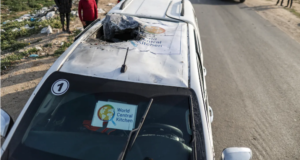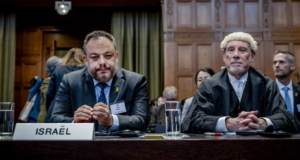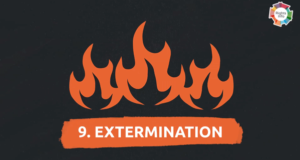Sharon Lock | Tales to Tell
6 February 2009

Haddad car, brothers of Ahsan and Adi Haddad in background
You remember the Nadeems (I must ring and ask them how Firas’s knee operation went so I can tell you) who tried to escape from the Israel’s attacks on Tela Howa in their car, but it wouldn’t start. Also on January 15, an hour or so afterwards at about 10.15am, their neighbours the Al Haddads tried to escape in their car.
They only got a few yards.
The Kabariti family told me about this, because M’s sister’s family are also neighbours to the Al Haddads. M took me up to hear the story from Mazin, brother to Adi Al Haddad. The Al Hadded family, in the same terror of remaining in their building to die that the Nadeems described, decided the safest way to leave was in their car. Believing they were about to lose everything, they took with them a large sum of money, the price of some family land that had just been sold. Adi, with his wife Ahsan, about 40, son Hatam, aged 20, daughter Ala’a, aged 14, and Mohammed aged 23, drove them from their sidestreet into their normally quiet road. To their right, a few hundred yards away, were the tanks that had targeted the Nadeems. To their left, a few hundred yards away, the main road that had already been hit by F16 planes.

from the car looking to the right: tanks were beside mosque
They got to where their road and the main road intersect. At this point the Israeli army struck the car from both tank and plane, it appears with 2 rockets or shells, and at least one phosphorous bomb. The car spun 15 metres away, and as one of the doors flew open, Mohammed was thrown out, catching only the inital brunt of the phosphorous before the car exploded. Abu Rami il Sharif, who lived in the same block as the Haddads and on the corner of this intersection, was able to reach him. As firing continued from the tanks, Abu Rami knew that he could not reach the car to help anyone else, but he knew also that there was no-one left to help.
Helmi Abu Shaban, living opposite Abu Rami on the other side of the street, ventured out to the car at midday. The phosphorous fire was still burning, and looking inside the car, he could see nothing to show any humans had ever been there. Not even any bones. Just ashes.
I went to see Mohammed in Al Shifa hospital last week. When I got there, Ramattan TV was waiting to interview him, and I couldn’t bring myself to ask him to tell the story to me also. I just told him quietly that I was sorry, and left. He has lost an eye and has burns all down one side of his body. I understand he has a little brother left him who wasn’t with the family at the time.

Looking to the left: the intersection. A black stain marks the attack. Helmi's on right

Mazin Al Haddad shows me pieces of phosphorous bombs
 International Solidarity Movement Nonviolence. Justice. Freedom.
International Solidarity Movement Nonviolence. Justice. Freedom.


